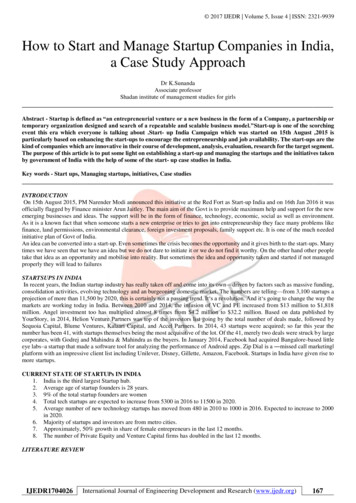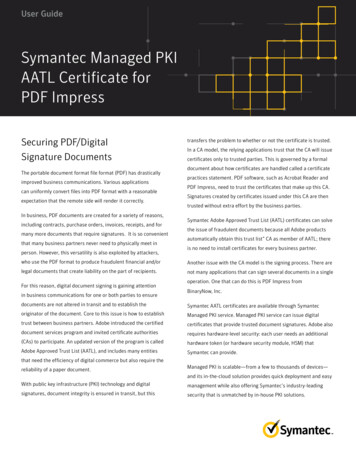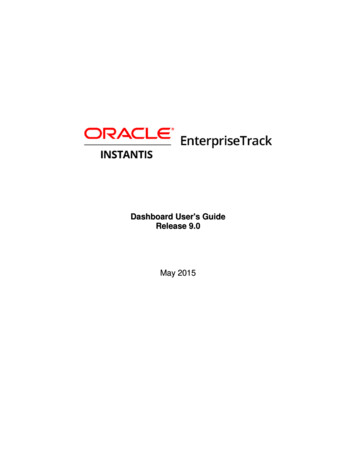
Transcription
2017 IJEDR Volume 5, Issue 4 ISSN: 2321-9939How to Start and Manage Startup Companies in India,a Case Study ApproachDr K.SunandaAssociate professorShadan institute of management studies for girlsAbstract - Startup is defined as “an entrepreneurial venture or a new business in the form of a Company, a partnership ortemporary organization designed and search of a repeatable and scalable business model.”Start-up is one of the scorchingevent this era which everyone is talking about .Start- up India Campaign which was started on 15th August ,2015 isparticularly based on enhancing the start-ups to encourage the entrepreneurship and job availability. The start-ups are thekind of companies which are innovative in their course of development, analysis, evaluation, research for the target segment.The purpose of this article is to put some light on establishing a start-up and managing the startups and the initiatives takenby government of India with the help of some of the start- up case studies in India.Key words - Start ups, Managing startups, initiatives, Case studiesINTRODUCTIONOn 15th August 2015, PM Narender Modi announced this initiative at the Red Fort as Start-up India and on 16th Jan 2016 it wasofficially flagged by Finance minister Arun Jaitley. The main aim of the Govt is to provide maximum help and support for the newemerging businesses and ideas. The support will be in the form of finance, technology, economic, social as well as environment.As it is a known fact that when someone starts a new enterprise or tries to get into entrepreneurship they face many problems likefinance, land permissions, environmental clearance, foreign investment proposals, family support etc. It is one of the much neededinitiative plan of Govt of India.An idea can be converted into a start-up. Even sometimes the crisis becomes the opportunity and it gives birth to the start-ups. Manytimes we have seen that we have an idea but we do not dare to initiate it or we do not find it worthy. On the other hand other peopletake that idea as an opportunity and mobilise into reality. But sometimes the idea and opportunity taken and started if not managedproperly they will lead to failuresSTARTSUPS IN INDIAIn recent years, the Indian startup industry has really taken off and come into its own—driven by factors such as massive funding,consolidation activities, evolving technology and an burgeoning domestic market. The numbers are telling—from 3,100 startups aprojection of more than 11,500 by 2020, this is certainly not a passing trend. It‘s a revolution. And it‘s going to change the way themarkets are working today in India. Between 2010 and 2014, the infusion of VC and PE increased from 13 million to 1,818million. Angel investment too has multiplied almost 8 times from 4.2 million to 32.2 million. Based on data published byYourStory, in 2014, Helion Venture Partners was top of the investors list going by the total number of deals made, followed b ySequoia Capital, Blume Ventures, Kalaari Capital, and Accel Partners. In 2014, 43 startups were acquired; so far this year thenumber has been 41, with startups themselves being the most acquisitive of the lot. Of the 41, merely two deals were struck by largecorporates, with Godrej and Mahindra & Mahindra as the buyers. In January 2014, Facebook had acquired Bangalore-based littleeye labs–a startup that made a software tool for analyzing the performance of Android apps. Zip Dial is a ―missed call marketing‖platform with an impressive client list including Unilever, Disney, Gillette, Amazon, Facebook. Startups in India have given rise tomore startups.CURRENT STATE OF STARTUPs IN INDIA1. India is the third largest Startup hub.2. Average age of startup founders is 28 years.3. 9% of the total startup founders are women4. Total tech startups are expected to increase from 5300 in 2016 to 11500 in 2020.5. Average number of new technology startups has moved from 480 in 2010 to 1000 in 2016. Expected to increase to 2000in 2020.6. Majority of startups and investors are from metro cities.7. Approximately, 50% growth in share of female entrepreneurs in the last 12 months.8. The number of Private Equity and Venture Capital firms has doubled in the last 12 months.LITERATURE REVIEWIJEDR1704026International Journal of Engineering Development and Research (www.ijedr.org)167
2017 IJEDR Volume 5, Issue 4 ISSN: 2321-9939Paul Graham says that "A startup is a company designed to grow fast. Being newly founded does not in itself make a company astartup. Nor is it necessary for a startup to work on technology, or take venture funding, or have some sort of "exit". The onlyessential thing is growth. Everything else we associate with startups follows from growth.A startup business is defined as an organization: Incorporated for three years or less At a funding stage of Series B or less An entrepreneurial venture/a partnership or a temporary business organization New and existence for not more than five years Revenue of up to INR 25 cr. Not formed through splitting or restructuringThomas Hillmann and Manju Puri (2000) examine the empirical evidences on the impact that the venture capitalists can have onthe development path of new firms. Their study suggests that there is soft facet to venture capitalists in terms of supportingcompanies to build up their human resources within the organization.Christopher A Pissarides (2001) in his paper studied that the role of company starts up costs for employment performance. Thispaper is highly theoretical one. The conclusion is the factors that can explain the differences in Labor Market performance arestructural and should be sought in the institutional structures of the countries.Omid Sharifi, Bentolhoda Karbalaei Hossain (2015) in their paper stated that the various financial challenges faced by theStartups in India. It also depicts the difficulties faced by the startups at the initial stage. The major findings are major leap intechnology have led investors to raise the bar in terms of how much leg work entrepreneurs are expected to do before even pitchingtheir companies.OBJECTIVES OF THE STUDY1. To study the initiatives taken by Govt of India for start up companies2. To study the different steps in establishment of Startups3. To suggest the various measures for successful management of Startups.4. To give the case studies of successful startups.Research MethodologyThis study is mainly based on the secondary data. These data are collected from various websites, journals, andnewspaper articles. The study is descriptive & conceptual in nature.INITIATIVES TAKEN BY THE GOVERNMENTThe govt plays an important role for establishing the new enterprises. The initiatives taken by the govtof India for start up are asfollows.1.2.3.4.5.6.7.8.9.10.11.12.13.14.Self certification: The main objective of the govt is to reduce the load on the start ups hence allowing them toconcentrate fully on their business and keeping the low cost of adherence. It will include labor laws and environmentrelated laws.Start-up India hub: A single contact point will be created for the start-ups in India, which will enable them to exchangeknowledge and access to funds.Register through app: An online portal, will be available in the form of a mobile application, which will helpentrepreneurs to interact with the govt and other regulatory officials.Patent protection: A monitoring system for patent inspection at reduced costs is being created by the centralgovernment. It will enhance perception and acquisition of the Intellectual Property Rights (IPRs) by the entrepreneursRs 10,000 crore fund: The government will develop a pool with a starting aggregation of Rs 2,500 crore and a totalaggregation of Rs 10,000 crore over four years, to help new entrepreneurs. The important role will be played by the LifeInsurance Corporation of India in blossoming this collection. The fund will be managed by a group of professionalsselected from the start-up industry.National Credit Guarantee Trust Company: A National Credit Guarantee Trust Company (NCGTC) will be createdwith a budget of Rs 500 crore per year for the next four years to help the drift of funds to entrepreneursNo Capital Gains Tax: Investments through venture capital funds are exempted from the Capital Gains Tax. The samepolicy will be executed on start-ups.No Income Tax for three years: Start-ups would not pay Income Tax for the first three years. .Tax exemption for investments of higher value: In case of ventures of higher amount than the market price, they willbe exempted from paying tax.Building entrepreneurs: Creative study plans for students will be implemented in over 5 lakh schools. Apart from this,there will also be an annual businessman grand provocation to develop high class businessmen.Atal Innovation Mission: This Mission will be propelled to revitalize ideas and motivate creative youngsters.Setting up incubators: A private-public partnership model is being considered for 35 new incubators and 31 innovationcentres at national institutes.Research parks: The government plans to lay seven innovative research parks, including six in the Indian Institute ofTechnology campuses and one in the Indian Institute of Science campus.Entrepreneurship in biotechnology: The government plans to construct 5 advanced biotech nests, 50 advanced bioincubators, 150 technology transplant offices and 20 bio-connect offices in the country.IJEDR1704026International Journal of Engineering Development and Research (www.ijedr.org)168
2017 IJEDR Volume 5, Issue 4 ISSN: 2321-993915. Dedicated programs in schools: The government plans to inculcate transformational programs for scholars in over 5lakh schools.16. Legal reinforce: A committee of moderators will give legal help and reinforcement in complying patent applicationsand other papers.17. Rebate: An exemption value of 80 percent of the total value will be given to the start ups on filing the patentapplications.18. 18). Easy rules: Standards of communal acquisition and mandate of switching have been easier for the entrepreneurs.19. Faster exit: If an entrepreneur is unsuccessful than the government will help him to get a particular resolution for theircomplication.APPROVALS AND OTHER REGULATORY PROCESSESSingle online clearance systemA commendable development in the pipeline is to bring an online approval window which will provide over 200 permits requiredby different industries from various government divisions. This new system for clearance approval for new entrepreneurs wouldallow them to apply for and track the status of their applications/license permits online.Simplification of regulatory regimeTo improve India’s ranking on the ease of doing business to 50 from the current ranking of 142 on the World Bank’s index, stepsare being taken to simplify business processes and regulations. According to a DIPP official, a government panel is working on apolicy that proposes exempting startups from a 22 federal rules and regulations such as: Proposal includes exemption from company and labour laws until a startups revenue touches to certain level. Certain tax exemptions for a specified period and Easing norms for raising capital globally.E-BIZ Portal: To boost young entrepreneurs and too make it easy to start your business. Budget 2015 has pitched for the whitespread usage of the recently launched e-biz portal. The portal integrates the regulatory permission at one source. The use of thisportal helps entrepreneurs for faster clearance for setting up of business.Mudra Bank: Several entrepreneurs in the MSME Sector have often complained about lack of difficulty in getting finances torun their business. So this bank has been set up for providing finance for Microfinance to the required individuals.Atal Innovation Mission: Finance Minister in the Budget 2015 has launched the Atal Innovation Fund. (AIM). AIM will be aninnovators promotion platform involving academics, entrepreneurs, and researches.ESTABLISHMENT OF START UPsSTAGES OF THE STARTUP LIFECYCLEPRE STARTUPDiscovery- Identify a potential scalable product/service idea for a big enough target market. Validation- The service or productdiscovered hits the market, looking for the first clients ready to pay for it.STARTUPEfficiency -The entrepreneur begins to define his/her business model and looks for ways to increase customer base constantly.Scale- Pushing the growth of the business aggressively while increasing its capacity to grow in every possible sustainable manner.GROWTHMaintenance- Maximizing benefits and facing problems derived from the global dimension in terms of competition that the businesshas achieved Sale or Renewal - The decision to sell the startup to a giant or acquire huge resources that the brand will need tocontinue growing as a venture.STARTUP FINANCING LIFE CYCLE1) Funding by Angel Investors/ Seed Funds Early stage startups rely on angel investors and seed funding. Invest solely into the entrepreneur with an idea. Does not encumber the entrepreneur with any corporate governance formalities2) Venture Capital Used to scale the company’s business model. Comes from larger institutional funds. Focus is on building the sales force and establishing a global presence,.3) Public markets Late stage startups can feel the need to expand more aggressively or actively innovate the products which requirelarger funds. Private equity funds together with public markets provide large amounts of liquidity to late stage startups.MANAGING THE STARTUPS TO AVOID FAILURES1. NEVER UNDERESTIMATE COMPETITION OR COMPETITORS19% startups have been underscored the challenge posed by their competitors. The competitors may out beat by theirstrategies. Startups should be able to develop the idea according to the market requirement to overcome competition.IJEDR1704026International Journal of Engineering Development and Research (www.ijedr.org)169
2017 IJEDR Volume 5, Issue 4 ISSN: 2321-99392.SERVE THE NEED OF THE MARKETThe idea developed by the startups should serve the market need otherwise customers are seldom interested in themodel they prepare. 42% of the startups fail due to this reason. The startups should be quick to adapt and be innovative.The business models developed should be able to serve the basic customer.3.PROPER ESTIMATION OF FUNDSThe most common problem faced by startups is shortage of funds. They somehow manage to get first round of fundingbut later when the venture requires more investment, they run out of cash. So, before starting of the venture properestimation should be done .The consistent sources of funds should be known.4.BUILD A DIVERSIFIED TEAMThe founding team couldn‘t build an MVP (minimum viable product) on its own. Some of the founders will notencourage others to enter into their business. Their should be enough workforce diversity to increase the synergiesskills. A well-rounded team should be formed without any personality clashes.5.PROPER MARKETINGA well marketed product can sustain whole business as seen in the case of many successful ventures. Knowing thetarget audience and pulling their attention and convert them into leads.6.PRICING STRATEGIESPricing is the most important attribute which if set wrongly can be detrimental to the start up. To survive in thecompetitive market they should adapt different pricing strategies which will attract customers towards their product orservice.7.CUSTOMER FEEDBACK SHOULD NOT BE IGNOREDIgnoring customers and not seeking their feedback can prove to be fatal flaws for most start ups. Always pay attentionto the customer’s feedback and adapt the products /services according to their needs.CASE STUDY1: ZOMATOZomato initially named as Foodiebay was started in 2008 by Mr. Deepinder Goyal. It is a restaurant searching platform providingin-depth details with autonomous reviews and ratings. Foodiebay, the initial name was changed to Zomato in November 2010 toincrease their reach among people. To differentiate themselves from their competitors, Zomato concentrated on adding approx.18,000 new places to eat from. Along with they also decorated many special features, such as pointed to particular dishes or openingtimes”.To be the largest resource in food supply market, Zomato bought urban spoon, a leading restaurant service providing portalfor 52 million to enter US, Canada and Australia to leverage local insights and experience and to expand their business in overseasseeing the future goal and objective.Vision To expand to more 50 countriesIJEDR1704026International Journal of Engineering Development and Research (www.ijedr.org)170
2017 IJEDR Volume 5, Issue 4 ISSN: 2321-9939Milestones: Number of listed restaurants: in 2008 it was 4000 restaurants which increase to 94000 in 2013 and currently 384,100 inQ1 of 2015. Monthly visitors of Zomato increases to 35 million in 2014 which was 11 million in 2013 and 0.015 million in 2008. Yearly revenue of Zomato in 2008 was 0.06 crores which increased to 11.3 crores in 2013. Spread in 21 countries worldwide.Success Factor: First mover advantage Strong content platform Efficient employees Good rating mechanism and social platform Funding from experienced sourceStrategy of Zomato: Zomato works with keen interest on various strategies to achieve their goal. It includes Financial strategy: To increase their fund and revenue Marketing strategy: To tap their customers from across the globe Growth strategy: To grow continuously and increase their customers and page traffic Globalization strategy: To expand themselves across the whole globe as a leading service providerMarketing Strategy Featured and user friendly website Global mobile app Focusing on digital marketing channels for potential customers Acquire the competitors: To be the largest resource in food supply market, Zomato bought urban spoon for 52 million toenter US, Canada and Australia Simpler review and rating systemIntegrating other tools in their marketing strategy has given them wonderful hike in their business. Sales promotion: Coupons and price-offs Direct Marketing: Phone call and direct mailInvestmentsIn August 2010, Zomato got its first round of funding of 1million from Info Edge, India. And in September 2011, got its secondround of funding of 3.5million from the same financier. Next year Zomato upraised its third round of another 2.5 million fromthe same investor and again in early 2013, Info Edge funded fourth round worth 10 million which gives them a 57.9% stake inZomato.Seeing the future and growth of Zomato, Sequoia Capital and Info Edge, India in November 2013 funded Zomato with 37 million.Info Edge now owned 50.1% of Zomato on an investment of INR 143 crores. The total funding raised by Zomato till November2013 stands at 53.5 million.In November 2014, Zomato came up with a fresh round of funding of 60 million at a post-money valuation of US 660 million.This round of funding was jointly headed by Info Edge India Limited and VY Capital, with involvement from Sequoia Capital. Thismade a total funding of over US 113 million for Zomato.Recently in a fresh round of funding in April 2015, Info Edge, India has invested an amount of Rs 155 crore in Zomato.Info Edge said in a statement “Being Info Edge’s fair share of Zomato’s recent fund raises of USD 50 million”. Upon completionof the allotment of shares, Info Edge’s aggregate investment in Zomato will be about Rs 484 crore.As the website was launched, it became popular soon and expanded rapidly, covering many important regions of India includingKolkata, Mumbai, Bengaluru and Pune by the year 2010. Apart from being a service provider within India, Zomato.com now hasbranched to overseas in the regions of Philippines, New Zealand, Qatar, South Africa, Sri Lanka, the United Arab Emirates and theUK as well.The website covers a list of over 1, 20,000 restaurants across all these regions catering to more than 15 million customersworldwide. With its headquarter in New Delhi, Zomato.com is providing career opportunity to over 350 employees all across theglobe.Social media StrategyZomato uses different platforms to engage their customers with them.IJEDR1704026International Journal of Engineering Development and Research (www.ijedr.org)171
2017 IJEDR Volume 5, Issue 4 ISSN: 2321-9939FacebookThere is a huge engagement of customers on Facebook. Zomato has more than 600k strong Facebook community.TwitterTwitter is a place where Zomato is sparkling. It has more than 114 k followers there. Used as a conversation platform with thecustomers, Zomato is doing a great job in engaging their customers on their page. They answers all the queries raised over theplatform by the customers.BlogSharing and updating with all the latest updates is a key point for any organization. Zomato uses their blog as their mouthpiece toshare all the latest updates.PinterestThe platform shares the food experience with great content to attract their customers. The company needs to do a lot of job to makeits followers on this platform which will certainly work in their promotion.InstagramThis platform lets the user share the foodie photographs just by sharing it using the tag # Zomato. The image automatically getsshared on the microsite.Success Story The key factor for Zomato success is its marketing strategy and in-depth knowledge of their competitors. Zomato aims to be a place where the foodies hangout. The company has spread in 20 countries with its headquarter in NewDelhi, India providing service to over 35 million values customers per month. The list of registered restaurants on thewebsite has increased to 384,100 till March 2015.IJEDR1704026International Journal of Engineering Development and Research (www.ijedr.org)172
2017 IJEDR Volume 5, Issue 4 ISSN: 2321-9939 Facebook, Twitter and Pinterest are the 3 main platforms which made the base for the success of Zomato with a deeppresence among their customers. Zomato has extensively invested a lot over SMO’s, SEO’s and has worked a lot to improve its UI and make it more userinteractive. Side by side with a goal to branch globally, they also invest much on TV ads to bombinate Zomato. Pankaj Chaddah, the co-founder of Zomato said that “ads on the mobile app have changed the revenue game for them”.More than 50% of their total traffic comes from their mobile apps. “Using location-based services to target ads around aconsumer’s physical location helps make this decision easier”.CASE STUDY 2: RED BUSPhanindra Sama, the chief executive officer of RedBus.in, is an engineer who chucked his lucrative job to startan enterprise of his own. It was started in August 2006 with a few seats from one bus operator, RedBus today is one of themost successful online bus ticket booking agencies. Today, it has 700 bus operators, 10,000 buses listed on it, works in 15states and sells around 5,000 tickets every day.The idea The founder Phanindra Sama during his Diwali vacation of 2005 was on the way to his home town Hyderabad. Makingthe plan in last moment left him with a single option to take a bus to reach his home. Phanindra roamed the whole city and looked everywhere for a ticket, but it was all sold out before he reached the travelagents. He then realized some major issues with the then-existing model level agents don’t have all the informationregarding all the possible bus operators. This lead to a gap and customers had to take decisions based on limitedinformation. Most of the agents were not able to sell return bus tickets.GROWTH AND REVENUERedBus started in August 2006 with INR 500, 000 which was the savings of the three co-founders. Operations and all thework started from a room of his house which was so called their office. They keep other parts of the house closed so that itgives them a feeling of working in an office. Three more relatives joined hands with him to help in the project.When the prototype was ready, they went to the bus operators and tried selling it to them, but the bus operators were noteven willing to take it for free. Then they went to TiE, Bengaluru with their business plan. TiE allotted them three mentorsto advice on the project.The first year was not a full year and we did Rs 50 lakh worth of business in the first financial year. There were no profits.Second year till the end of financial year 2008, it was a huge success. the turnover was INR 5 crore. In 2009, the companygrew six times and the turnover was INR 30 crore. In March 2010, the company had INR 60 crores turnover.Today, RedBus has more than 2 Crore users, 30,000 outlets, 80, 000 routes and 2300 bus operators belonging to 24 statesapart from road transport corporations of 5 states, and16000 daily uses.Earlier they crossed 10 million marks in no. of tickets sold in July 2012 and sold of 12 million tickets a year. It has 200 million Gross Merchandise Value. RedBus has been sold to ibibo group for 110 million.In mid of 2015, ibibo Group rolled out redBus in Singapore and Malaysia. With this launch, redBus is now available fortravelers to book inter-city bus tickets between Singapore and Malaysia, and intra-city tickets within Malaysia.Social media ScenarioRedBus banks upon a radically different approach as opposed to the sector. The brand uses the line of attack as self-promotion.The posts are not aimed at customer engagement as such, since most of the posts are focusing on the features of the brand. Thecontent bucket includes creative with crisp copies, highlighting the benefits and advantages of using RedBus.The Facebook page has a massive 1,000,000 fans with an average like of 500 people on a post. It also has more than 5000followers over Twitter. It engages the customers with various offers through the platform. Over its LinkedIn page, the companysees a crowd of more than 24000 followers.The strong market research on the idea, strong technical background that can be used for the idea implementation, innovativebusiness plan, mentors, aiming for the customer satisfaction, update of the work process and above all the first ever idea toimplement in India made RedBus a successful organization.COMPANY GOAL1. To achieve annual revenue of INR 6 Billion by 20162. To reach the target focus on short term strategiesSTRATEGIES To focus on the core business with value added services Attract new Traveler and increase customer base Increase the network by attracting new bus operations Increase the customer retention by increasing customer satisfaction To increase the awareness and credibilityAttract new Traveler and increase customer base Winning the confidence of travelers is important to attract new customers Needs marketing efforts to generate nationwide awareness Conduct low cost marketing campaigns like viral marketing using you tube, Form informative pages onfacebook displaying its services and range, use creative bill boards and hoardingsIncrease the network by attracting new bus operationsIJEDR1704026International Journal of Engineering Development and Research (www.ijedr.org)173
2017 IJEDR Volume 5, Issue 4 ISSN: 2321-9939 To penetrate the market red bus needs to expand its network of bus operators Attract new operators by show casing them the advantages they will avail Explain them the benefits by showing the results of their partnersIncrease the customer retention by increasing customer satisfaction Bus lounges for redbus travelers Travelers will be relieved from extreme weather India. Travelers satisfaction with the services will help in winning their loyalty It will also improve visibility of Red bus helping in increasing its awareness Launch loyalty programs to retain existing customersCONCLUSIONFor any new idea to become successful venture it requires appropriate support and mentoring. At present day, start ups aregrowing like a grapevine. Indian start-ups attempt to build the start up environment with important education, talent,innovation and incubators with correspondence to funding agencies. Now the govt is also supporting the Start-ups.According to Nasscom, India ranks third in global start-up ecosystem. More than 68% growth is seen in the year 2016.Startup is an opportunity for an entrepreneur to educate and inspire others while some are thinking of how to do and what to do.Although, entrepreneurs are facing problems but still they are rising like a sun. They have the determination to setup anddivert their energy to plan, support and execute their dreams and contributing to the growth of the economy. This newinitiative of start-ups pledge rapid approvals for starting the business, easier exits, tax rebates and faster registration for thepatents made easy for startups.REFERENCES[1] Y. Sharma, “Women entrepreneur in India”, IOSR Journal of Business Management, 15(2), 2013.[2] M. Goyal and J. Prakash, “Women entrepreneurship in India-problems and prospects”, Zenith International Journal ofMultidisciplinary Research, 1(5), 2011.[3] M.D. Ensley, K. M. Hmieleski and C. L. Pearce, “The importance of vertical and shared leadership with in new venture topmanagement teams: Implication for the performance of the startups”, 2006 .[4] N. Bosma, M. V. Praag, R.Thurik and G. D. Wit, “The value of human and social capital investment for the businessperformance of start-ups”, 2002.[5] M. Caliendo, S. Kunn, F. Wiebner and J. Hogenacker, “Subsidized start-ups out of unmployment: A comparison of regularbusiness start-ups, IZA Discussion Papers”, 8817, 2015.[6] S. P. Robbins, Organizational Behavior, Motivation concepts, (India :Pearson Education, 2009), 194.[7] https://en.wikipedia.org/wiki/Start-up company[8] https://en.wikipedia.org/wiki/Start-up India[9] http://www.iisermohali.ac.in/Start-upIndia ActionPlan 16January2016.pdf[10] -up[11] faced-start-
4. Total tech startups are expected to increase from 5300 in 2016 to 11500 in 2020. 5. Average number of new technology startups has moved from 480 in 2010 to 1000 in 2016. Expected to increase to 2000 in 2020. 6. Majority of startups and investors are from metro cities. 7. Approximately, 50% growth in share of female entrepreneurs in the last .










